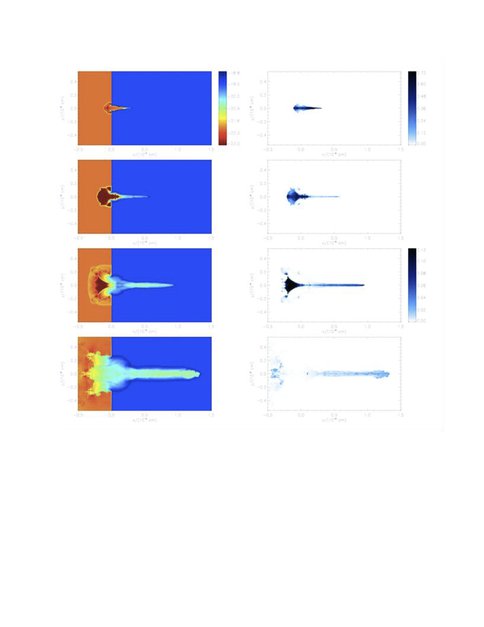2013 Annual Science Report
 Arizona State University
Reporting | SEP 2012 – AUG 2013
Arizona State University
Reporting | SEP 2012 – AUG 2013
Astrophysical Controls on the Elements of Life, Task 3: Model the Injection of Supernova Material Into Star-Forming Molecular Clouds
Project Summary
The goal of this task is to see if material ejected from a star that has exploded as a supernova can make its way into the gas as it is forming new solar systems. It has been expected that this material, because it is moving so fast (> 2000 km/s) when it hits the cold, dense molecular cloud in which stars are forming, would shock, heat up, and then “bounce” off of the cloud boundary.
Project Progress
A major breakthrough was accomplished last year and described in last year’s report. This work was published in the Astrophysical Journal in September 2012, and was also presented at the March 2013, Lunar and Planetary Science Conference. We engaged in high-performance computing, using 500,000 CPU hours on the ASU Arizona Center for Advanced Computing Saguaro cluster, to calculate the fate of supernova ejecta, as they collide with molecular cloud gas in the same star-forming region. The numerical challenge is that penetration of supernova gas relies on rapidly cooling, fragmentation and contraction of the ejecta, involving a range of lengthscales. We overcame these challenges and showed that supernova gas can cool quickly enough to penetrate into the molecular cloud.
Stars can be contaminated with supernova material just as they are forming, at contamination levels consistent with isotopic and chemical evidence from meteorites. There is a high probability (> 10%) of this event happening to stars like the Sun. Further details are described in our 2012 report.
A figure is reproduced from the paper that was published describing this result (Refer to Figure 1).
Publications
-
Pan, L., Desch, S. J., Scannapieco, E., & Timmes, F. X. (2012). MIXING OF CLUMPY SUPERNOVA EJECTA INTO MOLECULAR CLOUDS. The Astrophysical Journal, 756(1), 102. doi:10.1088/0004-637x/756/1/102
-
PROJECT INVESTIGATORS:
-
PROJECT MEMBERS:
Steven Desch
Project Investigator
Liubin Pan
Collaborator
Evan Scannapieco
Collaborator
Francis Timmes
Collaborator
Patrick Young
Collaborator
-
RELATED OBJECTIVES:
Objective 1.1
Formation and evolution of habitable planets.
Objective 3.1
Sources of prebiotic materials and catalysts
